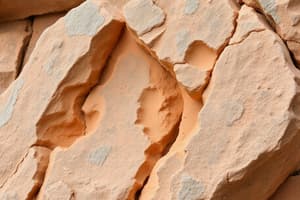Podcast
Questions and Answers
What type of stress occurs when rocks are squeezed together?
What type of stress occurs when rocks are squeezed together?
- Shear stress
- Compressional stress (correct)
- Lithostatic stress
- Tensional stress
Tensional stress is the main type of stress found at convergent plate boundaries.
Tensional stress is the main type of stress found at convergent plate boundaries.
False (B)
What is lithostatic stress?
What is lithostatic stress?
Pressure exerted equally in all directions by the weight of overlying rock.
The three types of differential stress are compressional stress, __________ stress, and shear stress.
The three types of differential stress are compressional stress, __________ stress, and shear stress.
Match the type of deformation with its description:
Match the type of deformation with its description:
Which response of a rock to stress is most likely to occur at the Earth's surface?
Which response of a rock to stress is most likely to occur at the Earth's surface?
Plastic deformation is more common in rocks at greater depths with high temperatures and pressures.
Plastic deformation is more common in rocks at greater depths with high temperatures and pressures.
What is shear stress?
What is shear stress?
Flashcards
Lithostatic stress
Lithostatic stress
Equal pressure exerted on a rock from all directions due to overlying rock weight.
Differential stress
Differential stress
Unequal stress on a rock due to tectonic forces.
Compressional stress
Compressional stress
Stress that squeezes rocks together.
Tensional stress
Tensional stress
Signup and view all the flashcards
Shear stress
Shear stress
Signup and view all the flashcards
Elastic deformation
Elastic deformation
Signup and view all the flashcards
Plastic deformation
Plastic deformation
Signup and view all the flashcards
Strain/Deformation
Strain/Deformation
Signup and view all the flashcards
Study Notes
Rock Behavior Under Stress
- Rocks change shape and volume when stressed.
- Stress is force per unit area on a rock.
Two Types of Stress
- Lithostatic Stress: Equal pressure from all directions, like water pressure deep underwater. Caused by the weight of overlying rock.
- Differential Stress (Deviatoric Stress): Unequal stress due to tectonic forces.
Three Basic Differential Stresses
- Compressional Stress: Pushes rocks together, causing them to fold or fracture. Common at convergent plate boundaries.
- Tensional Stress: Pulls rocks apart, causing them to lengthen or fracture. Common at divergent plate boundaries.
- Shear Stress: Forces are parallel but move in opposite directions. Common at transform plate boundaries.
Rock Response to Stress
- Strain/Deformation: Change in shape due to stress.
- Elastic Deformation: Rock returns to original shape after stress removed.
- Plastic Deformation: Rock does not return to original shape after stress removed.
- Fracture: Rock breaks.
- Rock response depends on type, surrounding temperature, pressure, time under stress, and stress type.
- High temperature and pressure deeper in Earth's crust create plastic, rather than brittle, deformation.
- Sudden stress (like a hammer blow) is more likely to cause fracture, while sustained, lower stress leads often to plastic deformation.
Studying That Suits You
Use AI to generate personalized quizzes and flashcards to suit your learning preferences.




